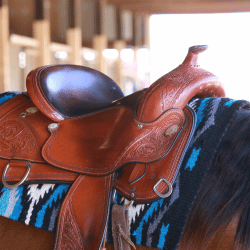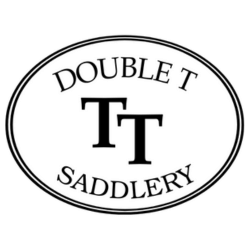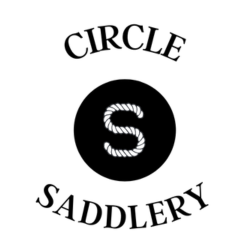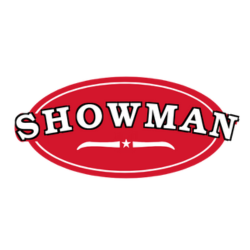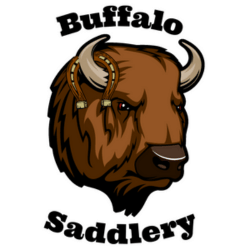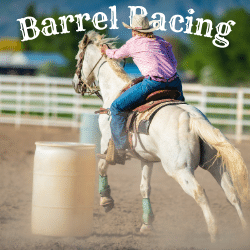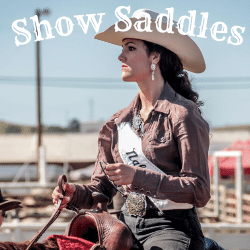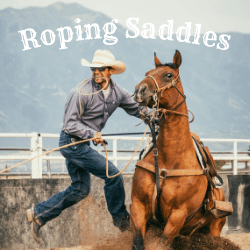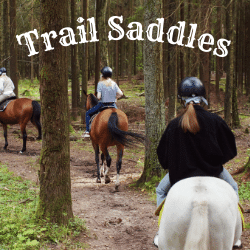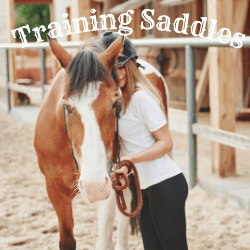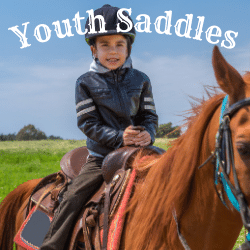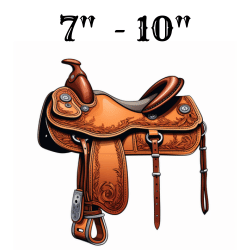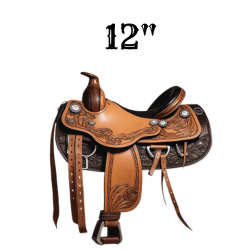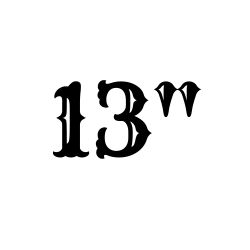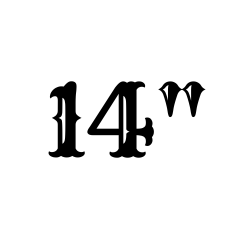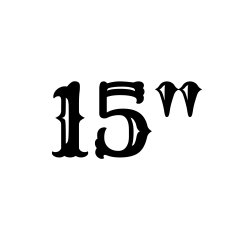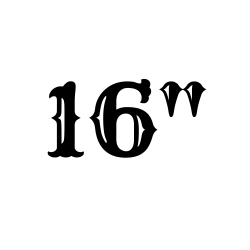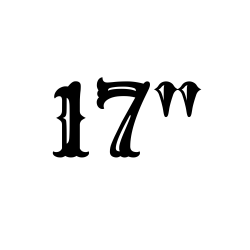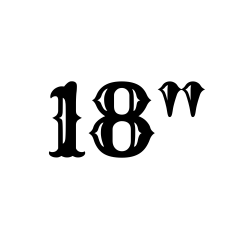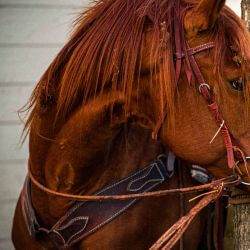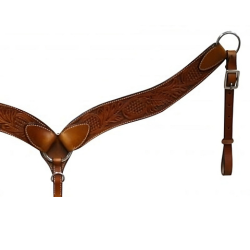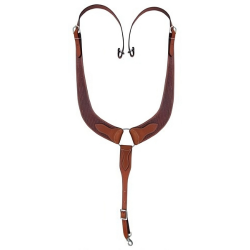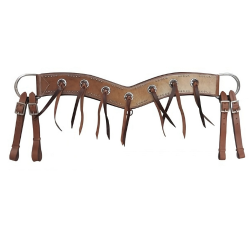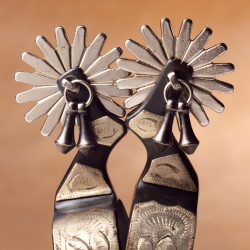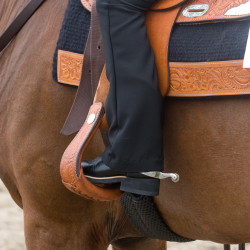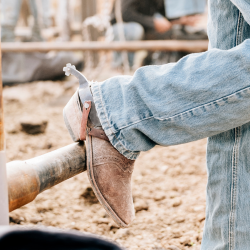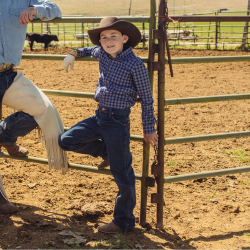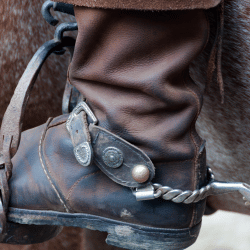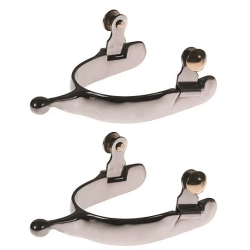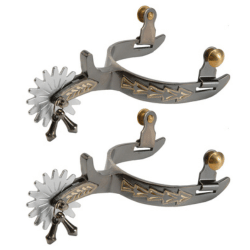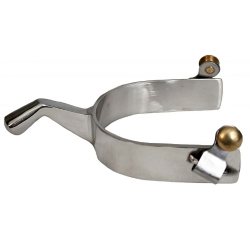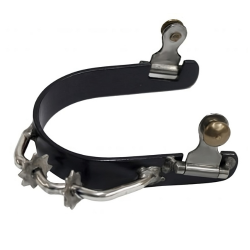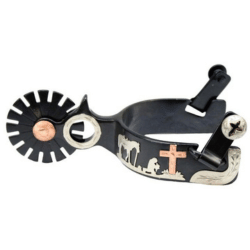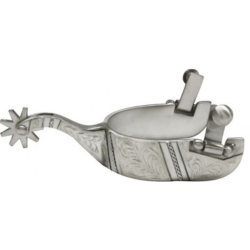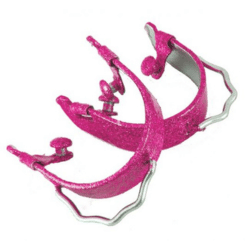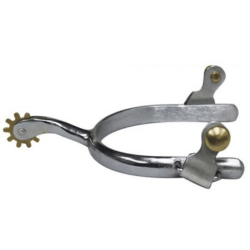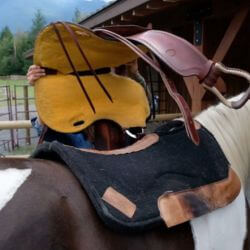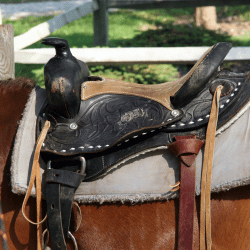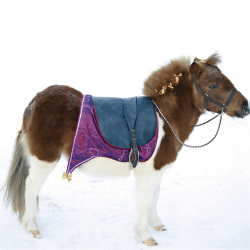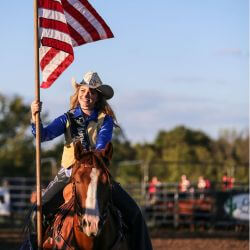For equestrians and horse enthusiasts, ensuring the comfort and safety of our equine partners is of utmost importance. One key piece of equipment that plays a crucial role in achieving this is the Western breast collar. Often overlooked or misunderstood, the Western breast collar is a valuable tool that provides support and stability to the horse's chest area, preventing saddle slippage and enhancing performance.
In this blog post, we will delve into the fundamentals of the Western breast collar, helping you understand its purpose and importance in horse riding. We will explore how to choose the right breast collar for your horse, taking into consideration factors such as size, breed, and material. Additionally, we will discuss the different styles and designs available, ensuring you make an informed decision.
Proper fitting of the Western breast collar is essential to guarantee the horse's comfort and safety. We will guide you through the correct positioning and adjustment techniques, providing tips to achieve a secure fit. By following these guidelines, you will be able to ride with confidence, knowing that your horse is comfortable and protected.
Maintenance is crucial to prolong the lifespan of any equestrian equipment, and the Western breast collar is no exception. We will share expert advice on regular cleaning and conditioning, as well as how to inspect for wear and tear. Proper storage techniques will also be discussed, ensuring your breast collar remains in optimal condition.
Finally, we will explore the numerous benefits and uses of a Western breast collar. From enhancing horse performance to preventing saddle slippage and improving overall horse comfort, this essential piece of equipment proves its worth time and time again.
Whether you are a seasoned rider or a beginner, understanding and utilizing a Western breast collar for horses is key to ensuring a safe and enjoyable riding experience. So, join us as we dive into the world of Western breast collars and discover how they can enhance your riding experience and the well-being of your equine companion.
Fundamentals: What is a Western Breast Collar?
The Western breast collar is a piece of equestrian equipment specifically designed to provide support and stability to the horse's chest area. It is commonly used in Western riding disciplines such as trail riding, roping, and ranch work.
The primary purpose of a Western breast collar is to prevent the saddle from sliding backward or shifting to the side during riding, which can cause discomfort and compromise the rider's balance. By securing the saddle in place, the breast collar helps maintain proper weight distribution and stability, ensuring the horse's comfort and safety.
A Western breast collar typically consists of a wide, padded strap that goes across the chest of the horse, just behind the shoulders. It is attached to the saddle's girth or cinch through adjustable straps or buckles on either side. Some breast collars feature additional attachments, such as a wither strap that connects to the horse's withers, providing extra stability.
The design of Western breast collars can vary, with options ranging from simple and functional to ornate and decorative. They are typically made from durable materials such as leather, nylon, or neoprene. The choice of material depends on personal preference, durability requirements, and intended use.
It is important to note that the Western breast collar should not be confused with the breastplate used in English riding disciplines. While both serve a similar purpose of preventing saddle slippage, the Western breast collar is specifically designed for Western-style saddles and is often more substantial in size and construction.
Now that we have covered the basics of what a Western breast collar is and its primary function, let us move on to exploring how to choose the right breast collar for your horse.
How to Choose the Right Western Breast Collar
Choosing the right Western breast collar for your horse is crucial to ensure proper fit, comfort, and effectiveness. There are several factors to consider when making this decision, including your horse's size and breed, material considerations, and the different styles and designs available. Let's explore each of these aspects in detail:
Understanding Your Horse's Size and Breed
Before purchasing a Western breast collar, it's essential to understand your horse's size and breed. Different horses have varying body shapes and chest sizes, so it's important to choose a breast collar that fits your horse properly.
Measure your horse's chest circumference by using a flexible measuring tape or a piece of string that you can measure later. Start at the center of the horse's chest, just behind the shoulder blades, and bring the tape or string around the widest part of the chest. This measurement will give you an idea of the size range you should be looking for in a breast collar.
Additionally, consider your horse's breed. Some breeds, such as draft horses or wider-chested breeds, may require a larger-sized breast collar to accommodate their body structure. Conversely, smaller or narrower breeds may need a more petite breast collar to ensure a proper fit.
Material Considerations
When choosing a Western breast collar, consider the material it is made from. The most common materials for breast collars are leather, nylon, and neoprene. Each material has its own advantages and considerations:
-
Leather: Leather breast collars are popular for their durability, classic look, and ability to conform to the horse's body over time. However, leather requires regular cleaning and conditioning to maintain its quality and may be more expensive than other materials.
-
Nylon: Nylon breast collars are lightweight, easy to clean, and affordable. They are also available in a wide range of colors and designs. However, nylon may not mold to the horse's body as well as leather and may not be as durable in extreme conditions.
-
Neoprene: Neoprene breast collars are constructed from a synthetic rubber material that is waterproof, resistant to sweat, and easy to clean. They provide excellent cushioning and are often preferred for horses engaged in high-intensity activities. However, neoprene may not have the same aesthetic appeal as leather or nylon.
Consider your horse's needs, your riding discipline, and personal preferences when choosing the material for your Western breast collar.
Different Styles and Designs
Western breast collars come in various styles and designs to suit different tastes and riding disciplines. Some common variations include:
-
Straight Breast Collar: This is the traditional style of Western breast collar, featuring a straight, wide strap that runs across the chest of the horse.
-
Pulling Breast Collar: This style is commonly used in working ranch and roping activities. It has a wider, contoured shape that provides extra support and stability during sudden stops or intense movements.
-
Padded Breast Collar: Padded breast collars feature additional padding on the chest strap for added comfort and to prevent rubbing or chafing.
-
Decorative Breast Collar: For those looking to add a touch of style and flair, decorative breast collars are available in various designs, such as tooling, conchos, or intricate patterns.
Consider the intended use, your personal style preferences, and any specific requirements of your riding discipline when selecting the style and design of your Western breast collar.
By taking into account your horse's size and breed, material considerations, and the different styles and designs available, you can make an informed decision and choose the right Western breast collar that ensures a proper fit and meets your specific needs. Now that we have covered the selection process, let's move on to the next section - how to properly fit a Western breast collar on your horse.
How to Properly Fit a Western Breast Collar on Your Horse
Properly fitting a Western breast collar on your horse is essential for their comfort, safety, and overall performance. A well-fitted breast collar ensures that it does its job effectively, preventing saddle slippage and providing support. In this section, we will guide you through the steps of fitting a Western breast collar correctly:
Understanding the Correct Positioning
-
Start by attaching the breast collar to the saddle. Most Western saddles have D-rings or clips on either side of the pommel or horn to connect the breast collar straps.
-
Position the breast collar strap across the chest of the horse, just behind the shoulder blades. It should sit snugly but not too tight, allowing the horse freedom of movement. The center of the breast collar strap should align with the center of the horse's chest.
-
Adjust the length of the straps on both sides of the breast collar. They should be adjusted evenly to ensure proper balance. The straps should be long enough to allow the horse to move comfortably but not too loose that they flop around or hang too low.
-
Check that the breast collar sits parallel to the ground and does not interfere with the horse's movement. It should not restrict the shoulder or cause any discomfort to the horse.
Adjusting for Comfort and Safety
-
Ensure that the breast collar is adjusted to fit snugly but comfortably around the horse's chest. It should not be so tight that it restricts the horse's breathing or causes discomfort. You should be able to slide your hand between the breast collar and the horse's chest with ease.
-
Check the wither strap, if present. This strap connects from the breast collar to the horse's withers, providing additional stability. Adjust the wither strap so that it sits comfortably against the horse's withers without causing any pressure points or rubbing.
-
Double-check the adjustment and fit of the breast collar after mounting the horse. Sometimes the horse's movement can cause the breast collar to shift or loosen. Make any necessary adjustments to ensure a secure fit before riding.
Tips to Ensure a Secure Fit
-
Regularly check the fit of the breast collar during rides or work sessions. The horse's body shape and condition can change over time, so it's important to ensure that the breast collar remains properly fitted.
-
Pay attention to any signs of discomfort or rubbing on the horse's chest. Adjust the breast collar accordingly if you notice any redness, hair loss, or irritation.
-
It's a good practice to have a professional or experienced equestrian assess the fit of the breast collar periodically. They may provide valuable insights and adjustments to ensure optimal fit and performance.
By following these steps and considering the comfort and safety of your horse, you can properly fit a Western breast collar. Remember to regularly check the fit and make adjustments as necessary to ensure a secure and comfortable fit for your horse. In the next section, we will discuss the maintenance of a Western breast collar to keep it in optimal condition.
Maintaining Your Western Breast Collar
Proper maintenance of your Western breast collar is essential to ensure its longevity, functionality, and safety. Regular cleaning, conditioning, and inspection will help keep the breast collar in optimal condition. In this section, we will discuss the key steps to maintain your Western breast collar:
Regular Cleaning and Conditioning
-
Start by removing any dirt, dust, or debris from the breast collar. Use a soft brush or cloth to gently brush off the surface. Pay attention to the areas where sweat and grime tend to accumulate, such as the underside and buckles.
-
Prepare a mild soap solution by mixing a small amount of saddle soap or leather cleaner with warm water. Avoid using harsh chemicals or abrasive cleaners that can damage the leather or other materials.
-
Dip a clean cloth or sponge into the soapy solution and gently clean the entire surface of the breast collar. Wipe away any dirt or stains, paying extra attention to any areas that are heavily soiled. Be careful not to saturate the leather or other materials with excessive water.
-
After cleaning, rinse the breast collar thoroughly with clean water to remove any soap residue. Ensure that all soap is completely rinsed off to prevent any potential skin irritation to the horse.
-
Allow the breast collar to dry naturally in a well-ventilated area, away from direct sunlight or heat sources. Avoid using artificial heat or hairdryers, as they can cause the leather to become brittle or warp.
-
Once the breast collar is completely dry, apply a leather conditioner or oil specifically designed for equestrian products. This will help restore moisture, prevent drying and cracking, and keep the leather supple. Follow the manufacturer's instructions for application and allow the conditioner to be absorbed before using the breast collar again.
Inspecting for Wear and Tear
-
Regularly inspect the breast collar for any signs of wear, tear, or damage. Check the stitching, buckles, and hardware to ensure they are in good condition and securely attached.
-
Look for any loose threads, broken stitches, or fraying edges. These should be repaired promptly to prevent further damage and maintain the integrity of the breast collar.
-
Examine the leather for any signs of cracking, dryness, or discoloration. Treat these issues with appropriate leather care products or seek professional assistance if needed.
-
Check the attachment points of the breast collar, such as the D-rings or clips. Ensure they are functioning properly and securely attached to the saddle.
Proper Storage
-
When not in use, store the Western breast collar in a clean and dry environment. Avoid storing it in damp or humid conditions, as this can promote mold or mildew growth.
-
Use a bridle bag or a dedicated storage container to protect the breast collar from dust, sunlight, and potential damage.
-
If storing for an extended period, periodically check the breast collar for any signs of deterioration or pest infestation.
By following these maintenance practices, you can prolong the lifespan of your Western breast collar and ensure its continued functionality and safety. Regular cleaning, conditioning, and inspection will help keep the breast collar in excellent condition and ready for use whenever needed. In the next section, we will explore the benefits and uses of a Western breast collar for horses.
Benefits and Uses of a Western Breast Collar
A Western breast collar offers numerous benefits and serves various purposes in horse riding. Understanding these advantages can help you appreciate the value of incorporating a Western breast collar into your equestrian activities. In this section, we will explore the benefits and uses of a Western breast collar:
Enhancing Horse Performance
-
Improved Balance: A properly fitted Western breast collar helps prevent the saddle from sliding backward or shifting to the side. This stability allows the horse to maintain a balanced and centered position, enabling better performance in various maneuvers.
-
Increased Maneuverability: By keeping the saddle securely in place, the breast collar allows the horse to move more freely and effectively execute turns, stops, and other maneuvers required in Western riding disciplines.
-
Weight Distribution: The breast collar helps distribute the rider's weight evenly across the horse's back and shoulders. This even distribution reduces stress and pressure points, enhancing the horse's overall comfort and performance.
Preventing Saddle Slippage
-
Safety and Stability: Saddle slippage can be dangerous for both horse and rider. A properly fitted Western breast collar acts as an additional safety measure, preventing the saddle from sliding backward or sideways during riding, particularly in challenging or fast-paced activities.
-
Confidence for Riders: Knowing that the saddle remains secure and in the correct position allows riders to focus on their riding technique and enjoy their time in the saddle with peace of mind.
Improving Horse Comfort
-
Reduced Discomfort: A well-fitted breast collar helps prevent the saddle from shifting and rubbing against the horse's back, which can cause discomfort, chafing, and potential sores. By providing stability and support, the breast collar enhances the horse's overall comfort during rides.
-
Minimized Pressure Points: The breast collar helps distribute pressure more evenly across the horse's chest and shoulders, reducing the risk of localized pressure points that can lead to discomfort or muscle soreness.
-
Enhanced Airflow: Some breast collars feature designs that allow for increased airflow around the horse's chest, minimizing heat buildup and promoting better ventilation, especially in hot or humid climates.
In conclusion, a Western breast collar offers several benefits and serves important functions in horse riding. From enhancing horse performance and preventing saddle slippage to improving horse comfort, the breast collar is a valuable accessory for Western riders. By understanding its advantages and utilizing it correctly, you can optimize your riding experience and ensure the well-being of your equine partner.

